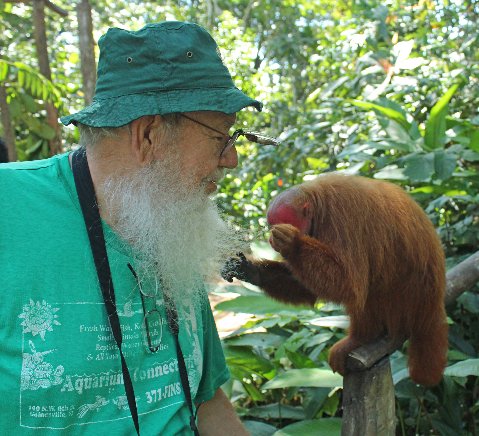Stopped by the little turtle pool, as I do each morning, and found a hatchling turtle floating in a patch of sunshine. I took a hurried look around on the surrounding land and found a a hole about an inch in diameter and 3 inches deep.
Inside were four eggshells. There was no question about the identification, The only species housed there had been
Rhinoclemmys pulcherrima incisa, the Guatemalan (painted) wood turtle. The adults were now in a large pen for the summer rainy season.
This turtle, if you’re not familiar with it has a brown, rough surfaced, carapace that may be quite flat, rather highly domed, or somewhere between these extremes. The carapace is a warm brown (color is sometimes hard to determine because these turtles are adept and persistent at kicking dirt upon themselves) and the yellow plastron bears a large, dark central blotch that is often weakly edged with pale rose.
But it is the facial neck and forelimb patterns that give rise to the common name of painted. The brown to grayish face and anterior neck bears a complex of thin, but easily visible, bright red stripes. The red striping is also present on the anterior surface of the forelimbs but there the striping is broader and even more pronounced. All in all, these are pretty turtles and at least as importantly, they are hardy and easily cared for.
It seemed apparent that there were no more hatchlings in the pond, so I began a methodical search of the surrounding area. Looking amidst and around the grasses disclosed one additional hatchling. The next day, following a hard rain, I found the third, and on the third day I found the fourth baby. I had now found a hatchling for each of the empty eggshells.
The hatchlings (all brought indoors) are quite like miniatures of the adults in appearance, but have less strongly textured carapaces and rosier plastrons.

I wonder if a second nesting occurred this summer. Another month and I should know.
More photos under the jump...
It is from the facial striping that this pretty turtle acquires one of its common names.

The roughened carapace of a hatchling Guatemalan (painted) wood turtle.

 Author, photographer, and columnist Richard Bartlett is one of the most prolific writers on herpetological subjects in the 20th century. With hundreds of books and articles to their credit, Richard and his wife Pat have spent over four decades documenting reptiles both in the field and in captivity. For a list of their current titles, please visit their page in our bookstore. Author, photographer, and columnist Richard Bartlett is one of the most prolific writers on herpetological subjects in the 20th century. With hundreds of books and articles to their credit, Richard and his wife Pat have spent over four decades documenting reptiles both in the field and in captivity. For a list of their current titles, please visit their page in our bookstore. |




To prevent automated Bots from commentspamming, please enter the string you see in the image below in the appropriate input box. Your comment will only be submitted if the strings match. Please ensure that your browser supports and accepts cookies, or your comment cannot be verified correctly.